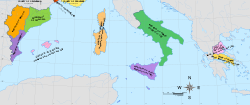
Back Krone Aragon ALS Corona d'Aragón AN تاج أرغون Arabic تاج اراجون ARZ Corona d'Aragón AST Araqon taxt-tacı Azerbaijani Арагонская карона Byelorussian Арагонска корона Bulgarian আরাগন সাম্রাজ্য Bengali/Bangla Kurunenn Aragon Breton
Crown of Aragon | |||||||||||
|---|---|---|---|---|---|---|---|---|---|---|---|
| 1164–1707/1715 | |||||||||||
 Diachronic map of the territories subject to the Crown of Aragon | |||||||||||
| Status | Composite monarchy[1] | ||||||||||
| Capital | See Capital below | ||||||||||
| Official languages | |||||||||||
| Co-official languages | |||||||||||
| Minority languages | |||||||||||
| Religion | Majority religion: Roman Catholic (official)[3] Minority religions: Islam, Sephardic Judaism, Greek Orthodoxy | ||||||||||
| Government | Feudal monarchy subject to pacts | ||||||||||
| Monarch | |||||||||||
• 1164-1196 (first) | Alfonso II | ||||||||||
• 1479–1516 | Ferdinand II | ||||||||||
• 1700–1715 (last) | Philip V / Charles III[nb 1] | ||||||||||
| Legislature | Cortz d'Aragón Corts Catalanes Corts Valencianes | ||||||||||
| Historical era | |||||||||||
• Aragon-Barcelona Union | 1164 | ||||||||||
| 1231 | |||||||||||
• Conquest of the Kingdom of Valencia | 1238–1245 | ||||||||||
| 1324–1420 | |||||||||||
| 19 October 1469 | |||||||||||
| 1501–1504 | |||||||||||
| 1707/1715 | |||||||||||
| Area | |||||||||||
| 1300[4] | 120,000 km2 (46,000 sq mi) | ||||||||||
| Population | |||||||||||
• 1300[4] | 1 000 000 | ||||||||||
| |||||||||||
| Today part of | Spain | ||||||||||
The Crown of Aragon (UK: /ˈærəɡən/, US: /-ɡɒn/)[nb 2] was a composite monarchy[1] ruled by one king, originated by the dynastic union of the Kingdom of Aragon and the County of Barcelona and ended as a consequence of the War of the Spanish Succession. At the height of its power in the 14th and 15th centuries, the Crown of Aragon was a thalassocracy controlling a large portion of present-day eastern Spain, parts of what is now southern France, and a Mediterranean empire which included the Balearic Islands, Sicily, Corsica, Sardinia, Malta, Southern Italy (from 1442), and parts of Greece (until 1388).
The component realms of the Crown were not united politically except at the level of the king,[5] who ruled over each autonomous polity according to its own laws, raising funds under each tax structure, dealing separately with each Corts or Cortes, particularly the Kingdom of Aragon, the Principality of Catalonia, the Kingdom of Majorca, and the Kingdom of Valencia. The larger Crown of Aragon must not be confused with one of its constituent parts, the Kingdom of Aragon, from which it takes its name.
In 1479, a new dynastic union of the Crown of Aragon with the Crown of Castile by the Catholic Monarchs, joining what contemporaries referred to as "the Spains",[6] led to what would become the Spanish composite monarchy under Habsburg monarchs. The Aragonese Crown continued to exist until it was abolished by the Nueva Planta decrees issued by King Philip V in 1707–1716 as a consequence of the defeat of Archduke Charles (as Charles III of Aragon) in the War of the Spanish Succession.
- ^ a b Fernández Albaladejo, Pablo (2001). Los Borbones: dinastía y memoria de nación en la España del siglo XVIII.... Marcial Pons Historia.
- ^ Jimeno Aranguren, Roldan; Lopez-Mugartza Iriarte, J. C. (2004). Vascuence y Romance: Ebro-Garona, Un Espacio de Comunicación. Pamplona: Gobierno de Navarra / Nafarroako Gobernua. pp. 250–255. ISBN 84-235-2506-6.
{{cite book}}: CS1 maint: multiple names: authors list (link) - ^ Collins, Wallace B. (2004). Orientation: A Journey: Trip Through Europe Asia And Africa. University of Pittsburgh Press. p. 428. ISBN 9780595310630.
- ^ a b Reilly, Bernard F. (1993). The Medieval Spains. Cambridge University Press. p. 139. ISBN 9780521397414. Archived from the original on 29 March 2024. Retrieved 11 October 2019.
The new kingdom of Castile had roughly tripled in size to some 335,000 square kilometres by 1300 but, at the same time, its population had increased by the same factor, from one to three millions [...] In the new Crown of Aragon of 120,000 square kilometres the population density would have been about the same for its numbers reached about 1,000,000 in the same period.
- ^ Ryder, Alan (2007). The Wreck of Catalonia. Civil War in the Fifteenth Century. Oxford University Press. p. v. ISBN 978-0-19-920736-7.
This group of states comprised the kingdoms of Aragon, Valencia, and Majorca, the principality of Catalonia, and the counties of Roussillon and Cerdagne; further afield it embraced the kingdoms of Sicily and Sardinia. These states had no common institutions or bonds save allegiance to a common sovereign
- ^ Kamen, Henry (2002). Empire: how Spain became a world power, 1492–1762, 20.
Cite error: There are <ref group=nb> tags on this page, but the references will not show without a {{reflist|group=nb}} template (see the help page).

